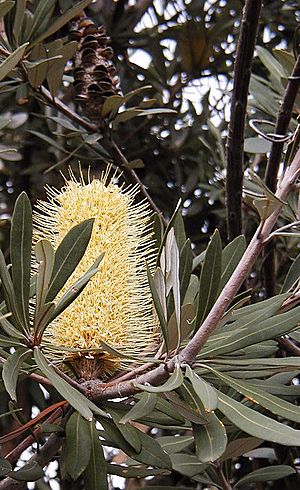Banksia integrifolia subsp. integrifolia facts for kids
Quick facts for kids Banksia integrifolia subsp. integrifolia |
|
|---|---|
 |
|
| Scientific classification |
|
| Kingdom: | Plantae |
| Clade: | Tracheophytes |
| Clade: | Angiosperms |
| Clade: | Eudicots |
| Order: | Proteales |
| Family: | Proteaceae |
| Genus: | Banksia |
| Species: | |
| Subspecies: |
B. i. subsp. integrifolia
|
| Trinomial name | |
| Banksia integrifolia subsp. integrifolia |
|
Banksia integrifolia subsp. integrifolia is a special type of plant that belongs to the Coast Banksia family. It's like a specific kind of plant within a larger group.
What Makes This Banksia Special?
You can tell Banksia integrifolia subsp. integrifolia apart from its close relatives by its leaves. Its leaves are a bit smaller and wider than other types of Coast Banksia. They also look a little less shiny compared to some of its cousins.
How Scientists Named This Plant
The first time scientists collected this plant was on April 29, 1770. This happened at Botany Bay in Australia. Sir Joseph Banks and Dr Daniel Solander found it. They were naturalists on the Endeavour ship. This was during Lieutenant (later Captain) James Cook's first big trip to the Pacific Ocean.
A scientist named Carolus Linnaeus the Younger officially named it "Banksia integrifolia L.f." in April 1782. For a long time, it was just known as a species. But in 1913, another scientist, Frederick Bailey, noticed a slightly different version. He called it B. integrifolia var. compar.
Later, in 1994, Kevin Thiele decided that these different versions were important enough to be called "subspecies." So, the original plant became B. integrifolia L.f. subsp. integrifolia. This means it's a distinct group within the Banksia integrifolia species.
Where Does This Banksia Grow?
Banksia integrifolia subsp. integrifolia usually grows in sandy soils that aren't very rich in nutrients. You can find it close to the coast, usually within 50 kilometres (about 30 miles) of the ocean.
This plant is found only in Australia. It grows along the coast from Bundaberg, Queensland in the north. It stretches south through New South Wales all the way to Geelong, Victoria. There are old records of it being found on islands in Bass Strait. However, it seems like it doesn't grow there anymore.

